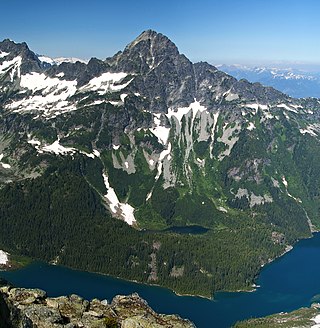
Alpha Mountain is a 2,302-metre (7,552-foot) summit located in the Tantalus Range, in Tantalus Provincial Park, in southwestern British Columbia, Canada. It is situated 14 km (8.7 mi) northwest of Squamish, and 4.6 km (2.9 mi) southeast of Mount Tantalus, which is the highest peak in the Tantalus Range. Its nearest higher peak is Serratus Mountain, 1.9 km (1.2 mi) to the west. The Serratus Glacier lies to the west of Alpha, unnamed glaciers lie on the northern and eastern slopes, and Lake Lovely Water lies below the south slope. Precipitation runoff from the peak drains into tributaries of the Squamish River.

Mount Matier is a prominent 2,783-metre (9,131-foot) mountain summit located in the Coast Mountains, in Joffre Lakes Provincial Park, in southwestern British Columbia, Canada. It is the highest point of the Joffre Group, which is a subset range of the Coast Mountains. It is situated 26 km (16 mi) east of Pemberton, and 9 km (6 mi) northeast of Lillooet Lake. Its nearest higher peak is Mount Weart, 30 km (19 mi) to the southwest. The slopes of the mountain are covered by the Matier Glacier on the northwest, Anniversary Glacier on the northeast, Twin One Glacier on the southeast, and Hartzell Glacier to the south. Precipitation runoff from the peak drains into Joffre Creek and Twin One Creek, both tributaries of the Lillooet River.

Joffre Peak is a 2,721-metre (8,927-foot) mountain summit located in the Coast Mountains, in Joffre Lakes Provincial Park, in southwestern British Columbia, Canada. It is the second-highest point of the Joffre Group, which is a subset of the Lillooet Ranges. It is situated 26 km (16 mi) east of Pemberton and 11 km (7 mi) northeast of Lillooet Lake. Joffre is more notable for its steep rise above local terrain than for its absolute elevation as topographic relief is significant with the summit rising 1,500 meters (4,920 ft) above Cayoosh Creek in 4 km (2.5 mi). The nearest higher peak is Mount Matier, 1.6 km (1 mi) to the south. The mountain's climate supports the Matier Glacier on the southwest slope, and the Anniversary Glacier on the southeast slope. Precipitation runoff from the peak drains into Joffre Creek and Cayoosh Creek which are both within the Fraser River watershed.
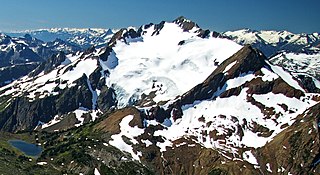
Cayoosh Mountain is a 2,561-metre (8,402-foot) mountain summit located in the Cayoosh Range in southwestern British Columbia, Canada. It is situated 22 km (14 mi) east-northeast of Pemberton, 12 km (7 mi) north-northeast of Lillooet Lake, and immediately north of Cayoosh Pass. Its nearest higher peak is Mount Marriott, 5.43 km (3 mi) to the north-northeast. Precipitation runoff from the peak drains into Cayoosh Creek and other tributaries of the Fraser River. The mountain's name was submitted by Karl Ricker, a mountaineer, and was officially adopted on January 23, 1979, by the Geographical Names Board of Canada.

Mount Weart is a 2,835-metre (9,301-foot) triple-summit mountain located in the Garibaldi Ranges of the Coast Mountains, in northwestern Garibaldi Provincial Park of southwestern British Columbia, Canada. It is situated 14 km (9 mi) northeast of Whistler, and its nearest higher peak is Wedge Mountain, 3.7 km (2 mi) to the south, which is the only peak within the park higher than Weart. The Armchair Glacier rests below the west aspect of the summit, and the massive Weart Glacier spans the northern and eastern aspects of the mountain. Precipitation runoff from the peak and meltwater from the glaciers drains into Wedgemount Lake and tributaries of the Lillooet River.
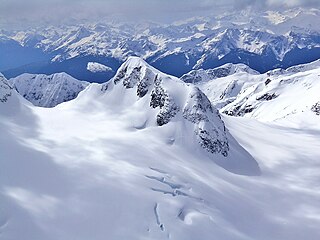
Mount Spetch is a 2,579-metre (8,461-foot) mountain summit located in the Coast Mountains, in Joffre Lakes Provincial Park, in southwestern British Columbia, Canada. It is part of the Joffre Group, which is a subset of the Lillooet Ranges. It is situated 25 km (16 mi) east of Pemberton, midway between Mount Matier and Slalok Mountain, both one kilometre either side of Spetch. The mountain's name was submitted by Karl Ricker of the Alpine Club of Canada to honor Samuel W. Spetch, who operated the general store at Birken, and other businesses in Pemberton. The name was officially adopted on January 23, 1979, by the Geographical Names Board of Canada. The first ascent of the mountain was made in 1971 by J. Oswald and G. Walter. Precipitation runoff from the peak drains into Joffre Creek and Twin One Creek, both tributaries of the Lillooet River. The mountain and its climate supports the Matier Glacier on the northern slope.

Parkhurst Mountain is a 2,494-metre (8,182-foot) mountain summit located in the Garibaldi Ranges of the Coast Mountains, in northwestern Garibaldi Provincial Park of southwestern British Columbia, Canada. It is situated 11 km (7 mi) east-northeast of Whistler, south of Wedgemount Lake, and on the west side of Wedgemount Glacier. Parkhurst's nearest neighbor is Rethel Mountain, 0.89 km (1 mi) to the northwest, and its nearest higher peak is Wedge Mountain, 1.8 km (1 mi) to the southeast. Mount Weart, the second-highest peak in the park, rises 2.6 km (2 mi) northeast of Parkhurst. Precipitation runoff from the peak drains into Wedge Creek, Wedgemount Creek, and Rethel Creek, which are all tributaries of the Green River, which in turn is a tributary of the Lillooet River. The present day ghost town of Parkhurst was an old logging town in the 1920s and 1930s set on the edge of Green Lake, 9 km (6 mi) west of Parkhurst Mountain. The site was named for Mr. and Mrs. Parkhurst who preempted the land on Green Lake in 1902 and built a small house where they lived with their family. The mountain's name was officially adopted on June 25, 1975, by the Geographical Names Board of Canada.

Mount Chief Pascall is a 2,206-metre (7,238-foot) mountain summit located in the Joffre Group of the Lillooet Ranges, in southwestern British Columbia, Canada. It is situated 26 km (16 mi) east of Pemberton, 8 km (5 mi) southwest of Duffy Lake, and within Nlháxten/Cerise Creek Conservancy. Cayoosh Pass lies immediately northwest of the mountain, with Cayoosh Mountain on the opposite side of the pass. Its nearest higher peak is Joffre Peak, 2.1 km (1 mi) to the south, and Mount Rohr rises 5 km (3 mi) to the northeast. Precipitation runoff from the peak drains into tributaries of Cayoosh Creek.
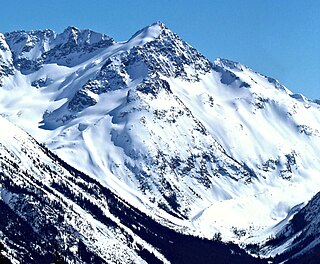
Mount Macbeth is a 2,639-metre (8,658-foot) glacier-clad peak located in the Garibaldi Ranges of the Coast Mountains, in Garibaldi Provincial Park of southwestern British Columbia, Canada. It is part of the Spearhead Range, which is a subset of the Garibaldi Ranges. It is situated 14 km (9 mi) southeast of Whistler, and 2 km (1 mi) south of Tremor Mountain, which is the highest point in the Spearhead Range. The Naden Glacier spreads out below the eastern aspect of the summit, the Macbeth Glacier lies below the south aspect, and the Curtain Glacier descends the northern slope. Precipitation runoff from the peak and meltwater from its glaciers drains into Fitzsimmons Creek which is a tributary of the Cheakamus River. Macbeth is most often climbed as part of the Spearhead Traverse. The first ascent of the mountain was made in 1969 by P. Starr, E. Bass, B. Ellis, and P. Macec via the northeast ridge. The peak was named in 1964 by an Alpine Club of Canada climbing party, to commemorate the 400th anniversary of William Shakespeare's birth. The mountain's name was officially adopted on August 27, 1965, by the Geographical Names Board of Canada.
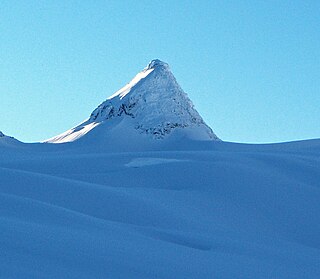
Mount Hartzell is a 2,615-metre (8,579-foot) mountain summit located in the Coast Mountains, in Joffre Lakes Provincial Park, in southwestern British Columbia, Canada. It is part of the Joffre Group, which is a subset of the Lillooet Ranges. It is situated 25 km (16 mi) east of Pemberton, midway between Mount Matier and Mount Spetch, each a half kilometre either side of Hartzell. The mountain's name was submitted by Karl Ricker of the Alpine Club of Canada to honor Carl A. Hartzell, an early settler and postmaster at Pemberton. The name was officially adopted on January 23, 1979, by the Geographical Names Board of Canada. Precipitation runoff from the peak drains into Joffre Creek and Twin One Creek, both tributaries of the Lillooet River. The mountain and its climate supports the Hartzell Glacier on the southeast slope, and the Matier Glacier on the northern slope.
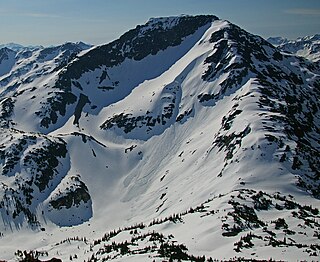
Mount Duke is a 2,379-metre (7,805-foot) mountain summit located in the Joffre Group of the Lillooet Ranges, in southwestern British Columbia, Canada. It is situated 30 km (19 mi) east of Pemberton, and 10 km (6 mi) southwest of Duffy Lake. The highest peak in the Joffre Group, Mount Matier, rises 4.4 km (3 mi) to the west. The mountain's name was submitted by Reverend Damasus Payne, a Benedictine monk and mountaineer, to honor Archbishop William Mark Duke. It was officially adopted on April 21, 1966, by the Geographical Names Board of Canada. Precipitation runoff from the peak drains into Caspar Creek and Twin One Creek.

Mount Rohr is a 2,423-metre (7,949-foot) mountain summit located in the Cayoosh Range of the Lillooet Ranges, in southwestern British Columbia, Canada. It is situated 29 km (18 mi) east of Pemberton, 8.2 km (5 mi) east of Cayoosh Mountain, and 6.8 km (4 mi) northeast of Joffre Peak, its nearest higher peak. Highway 99 traverses the southern base of the mountain between Cayoosh Pass and the west end of Duffy Lake, while Mount Chief Pascall rises on the opposite (south) side of this highway. Mount Rohr forms the westernmost boundary of Duffey Lake Provincial Park as it also represents the park's highest point. The mountain's name was submitted by Rev. Damasus Payne, a mountaineer, to honor Rev. Victor Sebastian Rohr (1873-1965), who spent 40 years in British Columbia and was a missionary to the First Nations in the region between Skookumchuck and Williams Lake. The name was officially adopted on April 21, 1966, by the Geographical Names Board of Canada. Two established climbing routes are the West Ridge and via Rohr Lake, both of which can be skied in winter. Precipitation runoff from the peak drains north into headwaters of Haylmore Creek, or south into Cayoosh Creek.

Mount Sampson is a 2,811-metre (9,222-foot) mountain summit located in the Thiassi Range of the Coast Mountains, in the Pemberton Valley of southwestern British Columbia, Canada. It is the highest point in the Thiassi Range. Sampson is situated 41 km (25 mi) northwest of Pemberton, and 21.5 km (13 mi) southeast of Mount Ethelweard, which is its nearest higher peak. Precipitation runoff from the peak drains into tributaries of the Lillooet and Hurley Rivers.
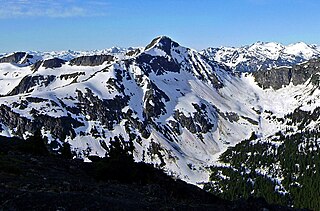
Mount Taylor is a 2,318-metre (7,605-foot) mountain summit located in the Coast Mountains, in Joffre Lakes Provincial Park, in southwestern British Columbia, Canada. It is part of the Joffre Group, which is a subset of the Lillooet Ranges. It is situated 21 km (13 mi) east of Pemberton, and 7 km (4 mi) northeast of Lillooet Lake. Its nearest higher peak is Slalok Mountain, 1.9 km (1 mi) to the east. Precipitation runoff from the peak drains into Joffre Creek, a tributary of the Lillooet River. The mountain's name was submitted by Karl Ricker of the Alpine Club of Canada to honor Ada C. Taylor, a Pemberton pioneer and the first nurse in that community. The toponym was officially adopted January 23, 1979, by the Geographical Names Board of Canada.

Tremor Mountain is a prominent 2,691-metre (8,829-foot) summit located in the Garibaldi Ranges of the Coast Mountains, in Garibaldi Provincial Park of southwestern British Columbia, Canada. It is the highest point of the Spearhead Range, which is a subset of the Garibaldi Ranges. It is situated 13 km (8 mi) southeast of Whistler, and 8.7 km (5 mi) south of Wedge Mountain, its nearest higher peak. Precipitation runoff from the south side of the peak as well as meltwater from the Platform Glacier drains into Fitzsimmons Creek which is a tributary of the Green River. Meltwater from the Tremor Glacier on the northwestern slope drains to Wedge Creek, and meltwater from the Shudder Glacier on the northeast slope drains into Billygoat Creek, a tributary of the Lillooet River. Tremor Mountain is often climbed as part of the Spearhead Traverse. The first ascent of the mountain was made in 1928 by A.J. Campbell Garibaldi survey party. The mountain's name origin refers to unexplained earth tremors when the first ascent party was on the summit. The mountain's toponym was officially adopted on September 6, 1951, by the Geographical Names Board of Canada.

Duffey Peak is a 2,219-metre (7,280-foot) mountain summit located in southwest British Columbia, Canada.
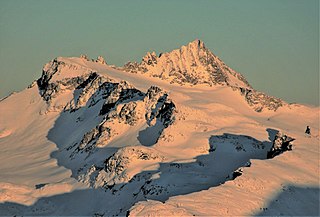
Mount James Turner is a 2,703-metre (8,868-foot) mountain summit located in British Columbia, Canada.
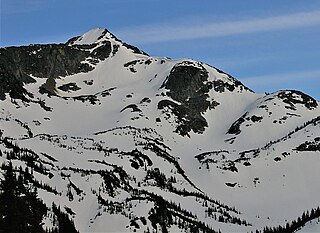
Vantage Peak is a 2,235-metre (7,333-foot) mountain summit located in the Coast Mountains of British Columbia, Canada. It is part of the Joffre Group, which is a subset of the Lillooet Ranges. It is situated 28.5 km (18 mi) east of Pemberton on the boundary of the Nlháxten/Cerise Creek Conservancy. Precipitation runoff from the peak drains southwest into Twin One Creek thence Lillooet Lake; the north slope drains into headwaters of Cerise Creek; and the east slope drains into Caspar Creek thence Cayoosh Creek which is within the Fraser River watershed. Vantage Peak is more notable for its steep rise above local terrain than for its absolute elevation as topographic relief is significant with the summit rising 1,135 meters (3,724 ft) above Twin One Creek in 4 km (2.5 mi). The nearest higher neighbor is Mount Duke, 2.08 km (1 mi) to the southeast.

Mount Howard is a 2,551-metre (8,369-foot) mountain summit located in the Coast Mountains of British Columbia, Canada. It is part of the Joffre Group, which is a subset of the Lillooet Ranges. Mount Howard is situated 27 km (17 mi) east of Pemberton and immediately southeast of Mount Matier. Precipitation runoff from the peak drains into Twin One Creek thence Lillooet Lake which is within the Lillooet River watershed. Mount Howard is more notable for its steep rise above local terrain than for its absolute elevation as topographic relief is significant with the summit rising 1,650 meters (5,413 ft) above Twin One Creek in 4 km (2.5 mi).

Kumkan Peak is a 2,742-metre (8,996-foot) mountain summit located in British Columbia, Canada.


























